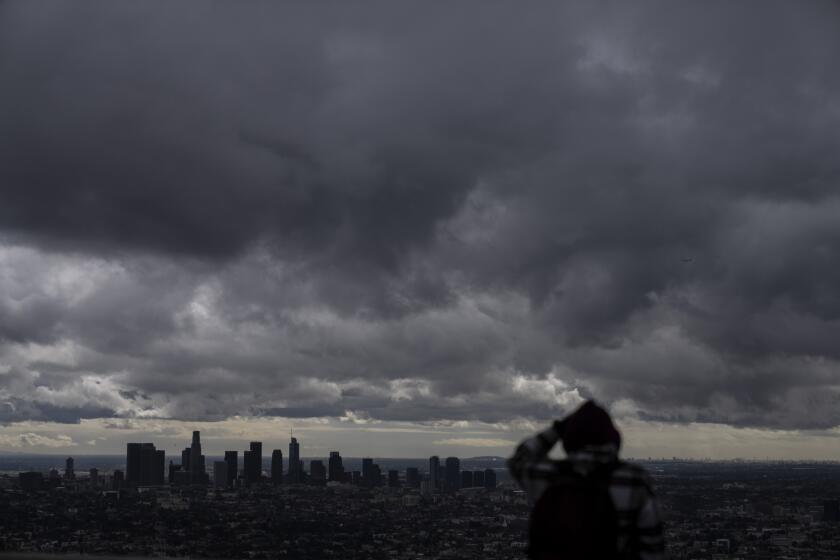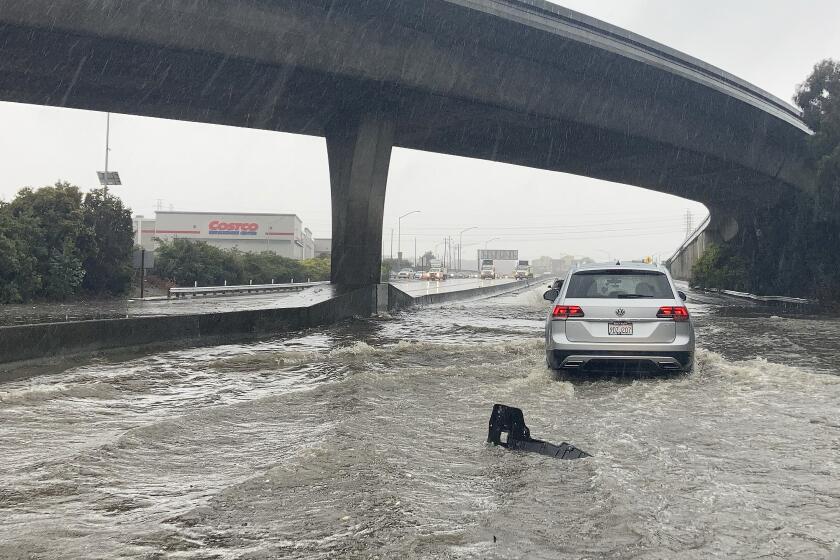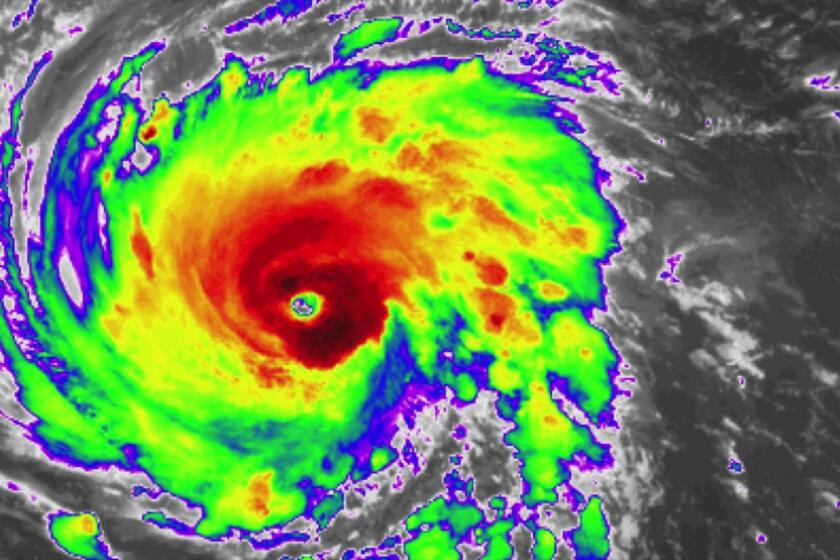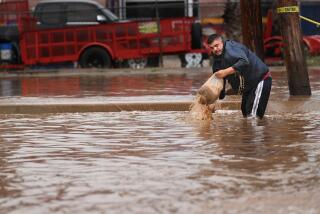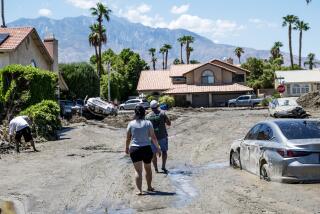Hurricane Hilary is bearing down on Southern California. What’s your flood risk?
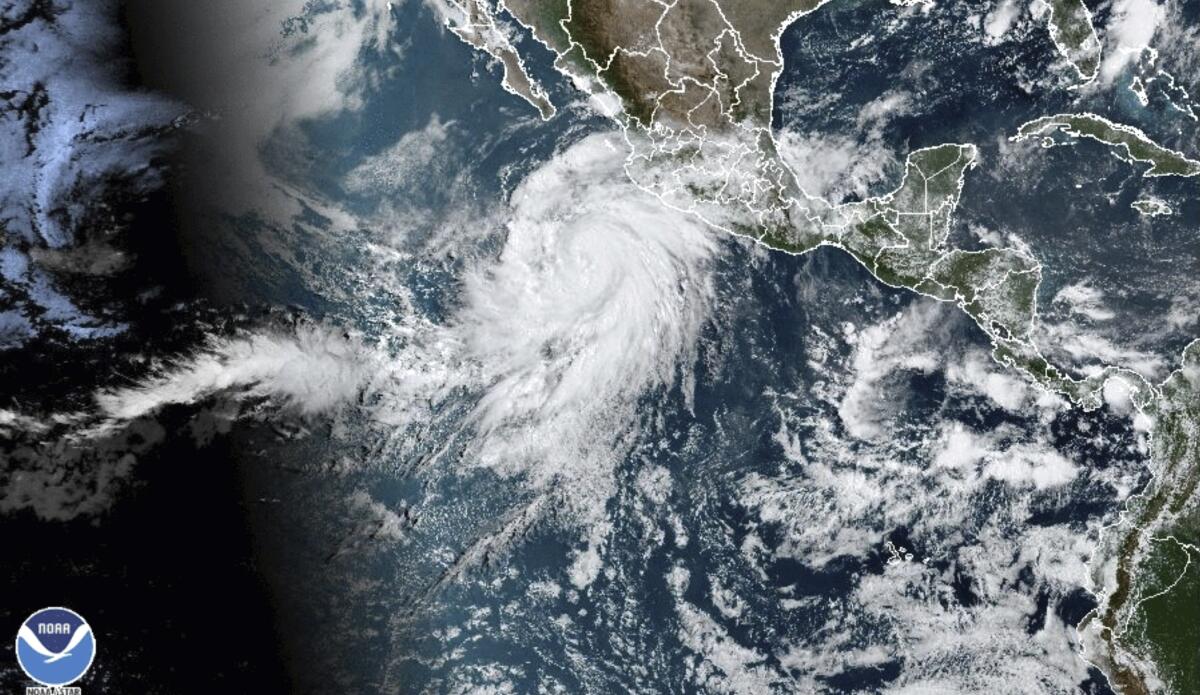
Brace yourself: Hurricane Hilary is expected to dump a lot of rain on Southern California on Sunday and Monday.
In the latest forecast from the National Weather Service, Hilary is projected to be at hurricane strength when it makes landfall on the Baja California peninsula over the weekend, then move in a north to northwest direction up the coast.
Eastern Los Angeles County could see some rain, starting with light showers, as early as Saturday evening. The rainfall is expected to spread throughout the county Sunday.
The hurricane is currently a Category 4, meaning it has sustained winds of up to 156 mph. The storm is expected to weaken before bringing rain and wind to Baja California and is likely to be a tropical storm (with sustained winds up to 73 mph) when it reaches Southern California.
Most of the region can expect 4 inches of rain; rainfall could amount up to 10 inches by Tuesday in the mountains and deserts of San Diego and Riverside counties, according to the National Hurricane Center.
Depending on the speed of the rainfall, forecasters are concerned about the potential for flash flooding.
Hurricane Hilary is moving toward Southern California. Here’s how to prepare and stay safe before and during the storm, heavy rain and potential flooding.
When the heavier rains hit Los Angeles and Ventura Counties on Sunday, residents should expect to receive an alert that their communities are on flood watch.
A flood watch differs from a flash flood warning. A flood watch means you should be prepared for a flood, including being ready to evacuate to higher ground, according to the National Weather Service. It’s issued when conditions are favorable for flooding — it doesn’t mean a flood will occur, it just means that there’s a possibility.
A flash flood warning means you should take action, including evacuating, because a flash flood is imminent or occurring.
Support our journalism
This article on Hurricane Hilary is free for all readers. Support our journalism with a subscription to receive more storm coverage.
As their name suggests, flash floods can develop quickly, sometimes in just a few minutes and without visible signs of rain, according to Ready L.A. County.
Be aware of flood hazards wherever you live, but especially if your home is in a low-lying area, near water or a recently burned hillside, Ready L.A. County advises.
Here are some tips for how you can prepare.
When an evacuation order reaches you, you need to leave. Now. Here’s how to prepare and what to have ready to go if you may need to evacuate during the rainstorms hitting California.
Check the flood risk in your area
Check a flood map to understand the flood risk in your community and whether your home is in a flood zone.
A flood zone means the area has a potential for flooding during heavy rains or a weather disaster.
Two government agencies — the Federal Emergency Management Agency and the California Governor’s Office of Emergency Services — provide information online about flood risks and other hazards across California. All you have to do is plug your address into the search tool to see what issues your home faces. You can find them at:
On the FEMA map, moderate- to low-risk flood areas are labeled with the letters B, C and X. In these areas the risk of being flooded is reduced but not eliminated. High-risk flood areas are labeled with the letters A and V.
A community’s flood risk changes over time, so the National Food Insurance Program and the Federal Emergency Management Agency continuously work with communities across the country to identify and map flood risks.
Tropical Storm Hilary threatens heavy rains, flash flooding, high winds and intense surf across Southern California this weekend. Here’s what to expect.
Prepare for flooding
Preparing for a flood — or any kind of emergency situation, for that matter — starts with you making a plan with your immediate family and neighbors.
Part of that plan includes packing a go-bag that should have important documents (in a Ziplock or another type of waterproof bag), medication, an extra set of glasses (or contacts), a comfortable pair of shoes, a change of clothes, small bills (a number of $1 and $5 bills), a phone charger, flashlight, water and nonperishable food.
If you have pets, pack food, treats and an extra leash if you have one.
Keep every family member’s needs in mind when creating your go-bag.
Emily Montanez, associate director for L.A. County’s Office of Emergency Management, said you should try to create a small community of close neighbors to check in with when disaster strikes. Consider creating an emergency contact list on paper in the event your phone stops working or the battery dies and you can’t check the contacts there, she said.
Wildfires in Canada and Hawaii. Hurricane Hilary set to strike California. Scientists have warned about worse storms and more frequent fires for years.
Follow emergency orders
If an evacuation is ordered or advised in your community, evacuate immediately.
Montanez said when it comes to safety, listen to first responders.
“If anyone receives a knock at their front door from someone in law enforcement or [from] the fire department, we definitely support taking the safest approach and evacuate your home,” she said.
Stay in the know about warnings and alerts by signing up with your local emergency mass notification system.
Los Angeles County residents can sign up with Alert L.A. County, Notify L.A. and Nixle to receive notifications via text message or email. Stay updated on weather forecasts by tuning in to your local news broadcast station and checking the National Weather Service Los Angeles office website.
If a flood warning or watch is issued for your community and you have some time before evacuating, relocate valuables (particularly water-sensitive ones, such as laptops, tablets and smart devices) from lower to upper floors. You should also disconnect all electrical appliances or turn off electric circuits at the fuse box or circuit breaker panel.
If you have been evacuated, wait until authorities give the all-clear to return to your home.
About The Times Utility Journalism Team
This article is from The Times’ Utility Journalism Team. Our mission is to be essential to the lives of Southern Californians by publishing information that solves problems, answers questions and helps with decision making. We serve audiences in and around Los Angeles — including current Times subscribers and diverse communities that haven’t historically had their needs met by our coverage.
How can we be useful to you and your community? Email utility (at) latimes.com or one of our journalists: Jon Healey, Ada Tseng, Jessica Roy and Karen Garcia.
More to Read
Sign up for Essential California
The most important California stories and recommendations in your inbox every morning.
You may occasionally receive promotional content from the Los Angeles Times.
